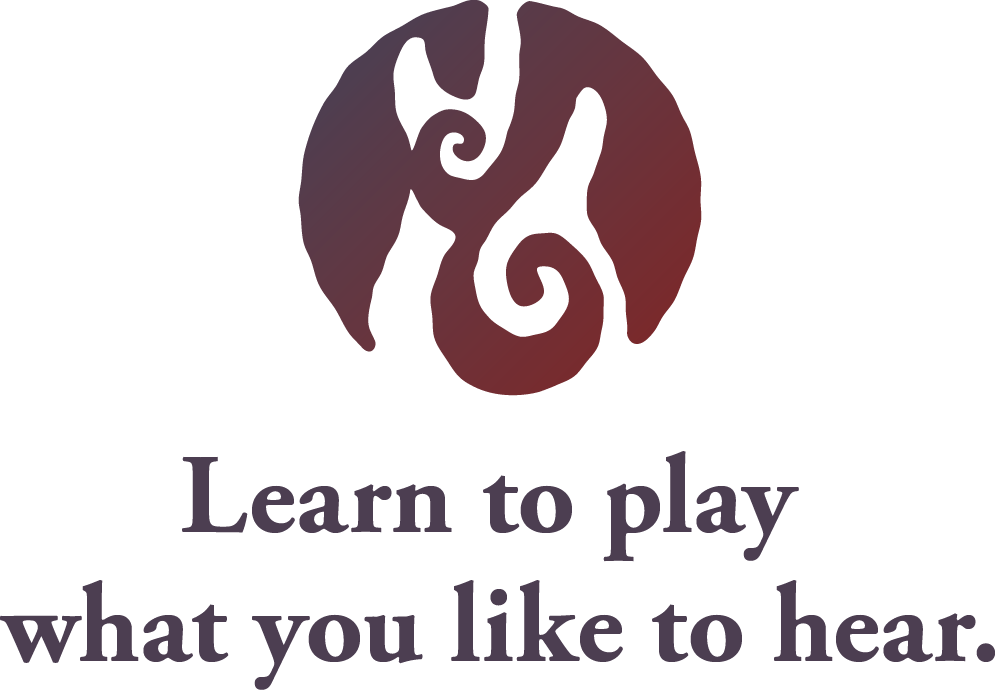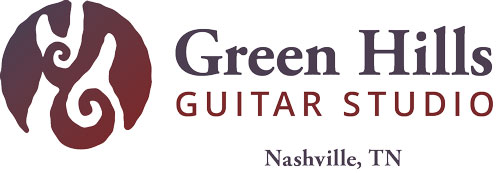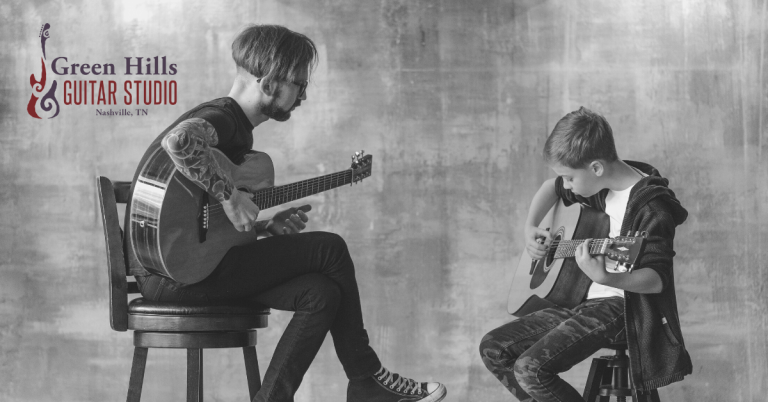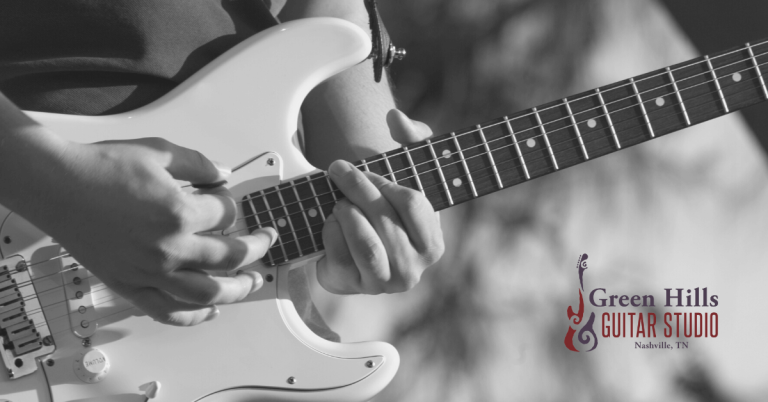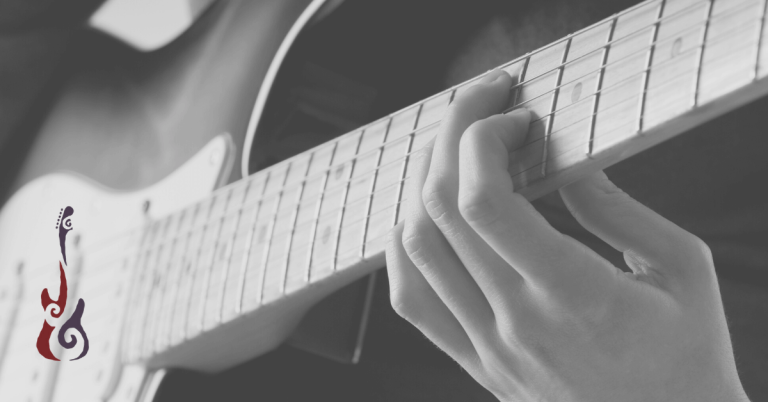The Beauty of Power Chords
Power chords are simple, versatile, and used by guitar pros all the time! Sometimes people think power chords are just for beginners or just for rock guitar, punk, or heavy metal, which is not the case. Whether playing live or in the recording studio, as a professional guitarist, I have used power chords in all styles of music, arranging parts with other guitarists and other instruments and utilizing everything from clean guitar tones to full-on fuzz and distortion.
Keep reading to learn how power chords can help improve your guitar playing.
Why Do Guitarists Use Power Chords?
For starters, power chords are moveable! Once you know a shape, it travels with you effortlessly to other keys and sometimes to other strings. To see how this works in action, check out the downloadable PDF at the bottom of this article. It shows two-finger power chords on the 6th, 5th, 4th, and open strings. That one-hand position, that one shape with two fingers, unlocks the chords on half of the guitar neck!!
Power chords are also great for arranging guitar parts when playing with multiple guitarists. Sometimes you need someone to hit the chord changes, maybe giving it some punch or fattening up the sound or the recording, band, or ensemble. It’s common to double guitar parts in the studio and live with power chords.
Keep in mind this happens all the time in other styles of music as well. Orchestrating parts and instruments is fundamental to music ensembles. In terms of rock guitar and masterful rock guitar rhythm playing, check out the Young brothers in that little band, AC/DC. You can’t argue with Malcolm’s rhythm playing, the riffs, and the level of songwriting.
Plus, guitar tone and chord quality can really affect how a band sounds and the overall aesthetic and energy needed and provided by the guitar. A super saturated and distorted guitar doesn’t sound good with 3rds and 7ths. This also helps with chromatic riffs and parts, which is why so many metal, punk, grunge, and alternative bands use power chords.
Keep in mind Wes Montgomery created a lot of great music with his thumb and octaves. And Hendrix used this approach with Marshalls and fuzz pedals. It’s all about function and the sound you are going for. For example, Kurt Cobain playing power chords on an acoustic guitar still works great!
Using Power Chords in a Large Ensemble
I write and play guitar in Amanda Broadway Band. We have a keyboard player, a lead singer, two background singers, two horn players, myself, a bass player, and a drummer. We combine rock, funk, soul, blues, and R&B. Sometimes, my role is to really drive what’s going on. Other times, I play a more supportive role to the keyboards and horns, and vocalists.
The overall harmony and sound of the band are always a focus for this large group. Everyone has to pay attention to what everyone else is doing, which can change from section to section. We are a very dynamic band, and as a guitarist, I always adjust my guitar parts, tone, and playing. I utilize power chords, clean and distorted, to help navigate and influence the sound of the band and my parts all the time. So does the keyboard player.
Power chords offer up a really full, open, and stable sound. the relationship between the root and the 5ths is called a Perfect 5th. It is the most stable pitch interval other than the octave. It’s a good thing to know how to use it!
Does Music Theory Matter?
I think so! Knowing the chord quality and where the root of the power chord is located also tells you the root of the barre chords, the scales, and the arpeggios you will soon be learning. Aside from memorizing the power chord’s shapes, which is fairly easy to do, it’s good to know where to find these notes on the guitar neck and how they relate to the key, chord progression, and the song or people you are playing with.
What if you want the 5th on the lowest string? Or the octave of the root on the 4th? What if the other guitarist is playing lower on the neck, and you want a middle part? How about a situation where you’re playing with a singer-songwriter with a capo on the 4th fret playing a G chord shape? What key is he/she in?
Sooner rather than later, it’s a good idea to know your guitar neck and understand basic music theory. Power chords are a great way to learn guitar, play a ton of songs, and understand and navigate the guitar neck…that beautifully maddening piece of fretted and fragmented cubist art with middle C in TWO places!?
What Are Power Chords?
A power chord is simply a 2 note chord. It comprises the root and the 5th of a chord, which can be the root and 5th of a major or minor scale.
Huh? A power chord isn’t major or minor?
That’s right! That means the 3rd is not in a power chord like in a basic triad.
The foundation of all basic chord construction is triads, and there are 4 types of triads:
- Major – Root, 3rd, 5th
- Minor – Root, flatted 3rd, 5th
- Diminished – Root, flatted 3rd and flatted 5th
- Augmented – Root, 3rd and a raised 5th
For example, when you play a G chord on a guitar or any instrument, you are playing these three notes: G – B – D; when you play a Gm chord, you are playing G – Bb – D; a G diminished chord is G – Bb – Db; and G augmented is G – B – D#.
- G Major: G – B – D
- G minor: G – Bb – D
- G diminished: G – Bb – Db
- G augmented: G – B – D#
Do you see the pattern? Some sort of G, B, and D note in each chord. If you look at a G power chord, G5, you get G and D notes. When reading a chord chart, you know to play a power chord when the “5” is present after the chord name. You can also duplicate or double the G or D notes on other strings to give the sound “more weight,” and it’s still a power chord.
How To Play Power Chords
As a guitar instructor in Nashville, I teach many songwriters and all guitar levels. I can tell you from years and years of seeing the confusion and frustration from people when they start to understand and see the connections on the guitar neck they really begin to take off. The anxiety decreases, and people feel more confident and comfortable with their playing.
Learning power chords provides the technical benefit of putting your left hand in a consistent and solid position to begin learning barre chords and scales. Also, learning the neck helps with the process of learning songs and playing with others. Guitar solos, licks, improvising, and music theory also come easier.
Here are some exercises using only power chords. Here are some exercises from a course called Learning the Guitar Neck, pt.1. The goals of these exercises are to help you:
- Begin to learn and memorize the guitar neck
- Develop left-hand strength, consistent hand position, and fundamental technique
- Transition between chords more smoothly
- Learn to palm mute
- Develop your ear training skills
- Set you up to begin learning your favorite songs
- Learn the fundamentals of rhythm, counting, and playing in time
- Learn common chord progressions used in songs
Power Chords Fretboard Diagram

6th String Power Chord Exercise

5th String Power Chords Exercise
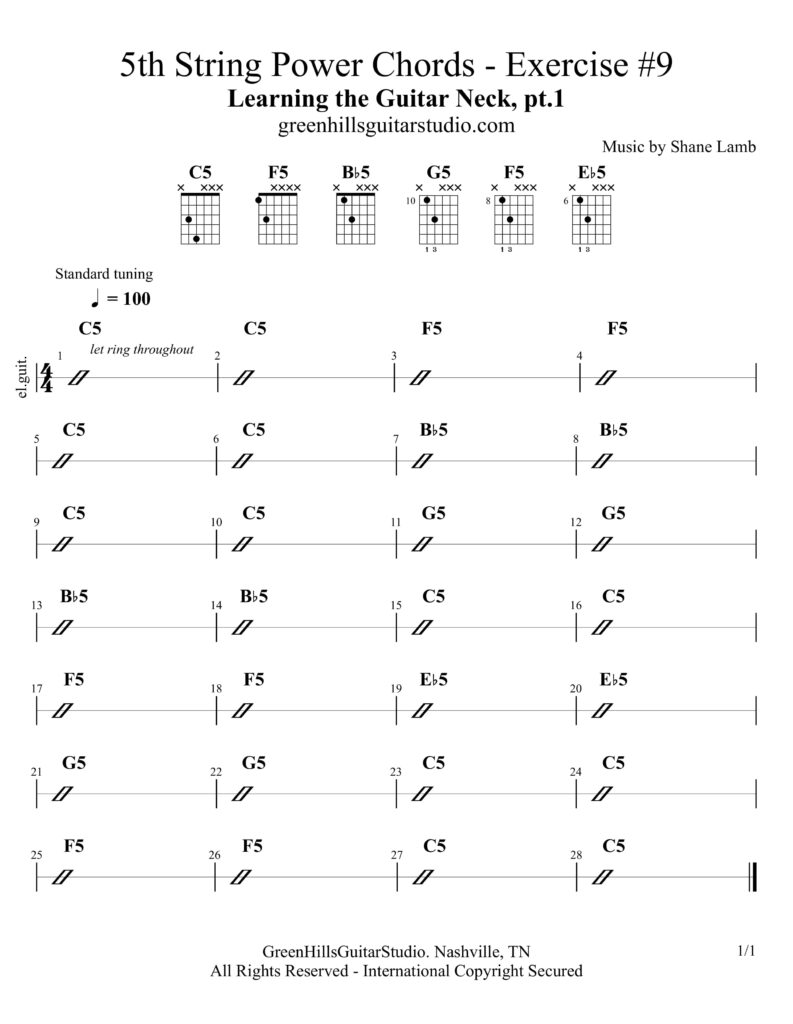
Power Chord Alternative
